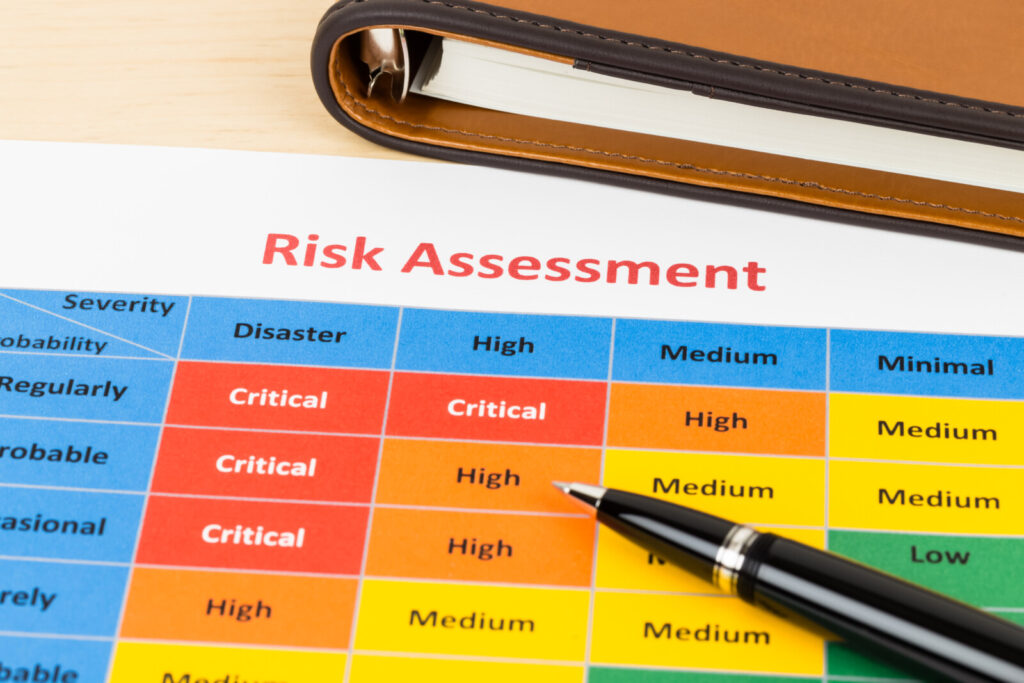Our Highfield Level 2 and 3 Award in Risk Assessment programmes provides learners with the understanding of the responsibilities of employers; the main causes and costs of work-related fatalities, injuries, and ill-health; the role of risk assessment in the prevention of accidents and ill-heath; the requirements of a risk assessment; a process for undertaking a risk assessment; and a method to evaluate risk. This course programme is achieved by taking a one-day classroom-based session consisting of six learning hours. It is assessed by a multiple-choice examination.
If you are unsure whether a Risk Assessment programme would be suitable for you or your organisation, we have asked our Training Development and Delivery Lead, Henry Pattison some questions about the course to help in your decision making.
What is a risk assessment?
A risk assessment is a process to evaluate hazards, followed by removing that hazard or minimising the level of its risk by adding control measures, as necessary. By doing so, you have created a safer and healthier workplace. The aim is to try to answer the following questions:
- What can happen and under what circumstances?
- What are the possible consequences?
- How likely are the possible consequences to occur?
- Is the risk controlled effectively, or is further action required?
Are risk assessments important?
Yes! Risk assessments are very important as they will form an essential part of a health and safety policy/plan. Any assessment of risk will ensure the following:
- Create awareness of hazards and risks.
- Identify who may be at risk (e.g., employees, visitors, contractors, students, the public, etc.).
- Determine whether a control program is required for a particular hazard.
- Determine if existing control measures are adequate or if more should be done.
- Prevent injuries or illnesses, especially when done at the design or planning stage.
- Prioritise hazards and control measures.
- Meet legal requirements where applicable.
When should a risk assessment be done?
There are many reasons why a risk assessment is needed. These include:
- Before new processes or activities are introduced.
- Before changes are introduced to existing procedures or activities, including when props or perhaps equipment change or new information concerning harm becomes available.
- When hazards are identified.
How are the hazards identified?
Generally, the aim is to find and record possible hazards that may be present in your workplace. It may help to work as a team and include both people familiar with the work area, as well as people who are not – this way you have both the experienced and fresh eye to conduct the inspection. In either case, the person or team should be competent to carry out the assessment and have good knowledge about the hazard being assessed, any situations that might likely occur, and protective measures appropriate to that hazard or risk.
Who should undertake a risk assessment?
Assessments should be done by a competent person or team of individuals who have a good working knowledge of the situation being studied. Include either on the team or as sources of information, the supervisors and workers who work with the process under review as these individuals are the most familiar with the operation.
Do I need any previous qualifications before attending a risk assessment programme?
You don’t necessarily need specific qualifications or training to carry out a risk assessment but as an employer, it is your duty to keep your colleagues safe and appoint a competent person to meet your health and safety duties. It is strongly advised for any person appointed as a competent person to conduct risk assessments in the workplace to attend a Level 2 or Level 3 Risk Assessment programme. Trident Manor Training Academy provides both courses in which they are nationally recognised qualifications.
Is risk assessment training a legal requirement for some organisations?
The Health & Safety Executive states on their website, “ the law states that a risk assessment must be ‘suitable and sufficient’, Therefore, it should show that:
- a proper check was made.
- you asked who might be affected.
- you dealt with all the obvious significant risks, taking into account the number of people who could be involved.
- the precautions are reasonable, and the remaining risk is low.
- you involved your workers or their representatives in the process.
The level of detail in a risk assessment should be proportionate to the risk and appropriate to the nature of the work. Insignificant risks can usually be ignored, as can risks arising from routine activities associated with life in general, unless the work activity compounds or significantly alters those risks.
Your risk assessment should only include what you could reasonably be expected to know – you are not expected to anticipate unforeseeable risks”.
Why is risk assessment training important?
Our Level 2 and Level 3 Risk Assessment Training programmes are key Health & Safety courses that teach you both what risk assessments are, as well as how and when to perform them. Understand the benefits of comprehensive risk assessments and comply with basic legislation. Our Level 2 and 3 Risk Assessment programmes are approved and awarded through Highfield Qualifications.
We hope this Q+A blog was useful to identify whether a risk assessment training programme would be suitable for your organisation. If you have any further questions or would like to discuss a location for us to deliver the programme please contact Henry Pattison on 01325 734850 or via his email. We hope to hear from you soon.

